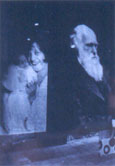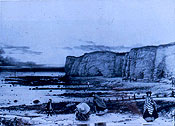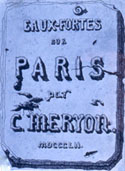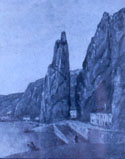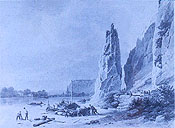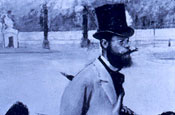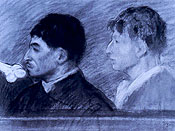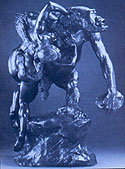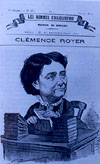The browser will either open the file, download it, or display a dialog.
|
|
Introduction: The Darwin Effect |
|||||
|
This paper represents the outcome of about two months of total immersion in Darwin, evolutionary theory and relevant histories of science. My self-designed crash course began at the beginning with Darwin for Beginners, an engaging and informative grown-up comic strip by Jonathan Miller and Borin van Loon and proceeded to more scholarly texts like Gillian Beer's Darwin's Plots; Stephen J. Gould's Ever Since Darwin; and The Wider Domain of Evolutionary Thought, a collection of essays edited by David Oldroyd & Ian Langham. Then it was on to more specific studies, like Joy Harvey's brilliant articles and monograph on Clémence Royer, Darwin's first French translator, and Evelleen Richards' essay "Redrawing the Boundaries: Darwinian Science and Victorian Women Intellectuals." The results of my concentrated period of research have tended to be aleatory if not downright serendipitous, rather like evolution itself: one thing led to another—or didn't. I have divided up my thoughts on the subject, like Gaul, into three, rather unequal, parts: 1) the "Darwin effect" on some nineteenth-century art and artists; 2) evolution and the representation of a single species—the horse; and 3) evolution and gender theory—or, less anachronistically—the "woman question." | |||||
|
I.
Once I began focusing on evolution in preparation for this symposium, Darwin and the "Darwin effect" seemed to be everywhere. In the Parrish Museum in Southampton I encountered Carrie Mae Weems' 1999 installation, The Jefferson Suite, where Julia Margaret Cameron's photograph of Charles Darwin, digitally reproduced on a semi-transparent banner, filmily omniscient, formed the centerpiece of the artist's meditation on The Origin of Species, DNA, Thomas Jefferson, and the impact of evolutionary theory and genetic coding for Black Americans, past and present. (fig. 1) But of course there were "Darwin effects"—references to evolution and evolutionary theory—before Darwin had even published The Origin in 1859. Darwin's controversial publication had been preceded by a plethora of theories and texts challenging the Biblical account of creation: notions that nature, instead of being stable and static, the result of Divine intervention, was perpetually on the move, expanding, developing, diminishing. Jean-Baptiste Lamarck, Robert Chambers, Charles Lyell, and Alfred Russell Wallace had all contributed to the development of evolutionary thought, though only Wallace had suggested that natural selection, the keystone of Darwin's evolutionary edifice, played an essential role in the development of living species.1 |
||||||
|
Two works by minor artists that I reencountered at an interesting session of the College Art Association in Chicago in 2001 both bear witness to the effects of evolutionary ideas before the publication of The Origin. The Englishman William Dyce and the French graphic artist Charles Meryon both foreground the impact of extended time, of eons and eons of change and development, on the immediate perception of the here and now. As Marcia Pointon has asserted, Dyce's Pegwell Bay: A Recollection of October 5, 1858 "is a painting about time, explored through an image of a particular moment in time."2 (fig. 2) On the one hand, the date in the title refers to the day when Donati's comet appeared at its most brilliant and when its progress was recorded by astronomers all through Europe. On the other hand, as Pointon nicely puts it, "Astronomy is accompanied by her sister muse, geology," apparent in the fossil-embedded chalk cliff and shell-strewn beach.3 It is clear that Dyce had read Lyell's Principles of Geology, published from 1830–33, in which this revolutionary work established the modern view that the greatest geological changes were the result of processes taking place over time rather than being the result of stupendous events. |
|||||
|
The case of Meryon is even more interesting—and less apparent. (fig. 3) In the words of Meryon scholar Roger Collins, "the block of stone of the title page presents itself as fundamental to the Eaux-Fortes sur Paris by deliberately depicting the calcareous, fossilferous building stone on which Paris stands, and of which it is built. . ."4 The antiquity of Paris is older than history, Meryon implies with this trope, its origins embedded in prehistory like the fossil shells in its foundations. In the "Ministère de la Marine" print from the same series, Meryon's strange creatures—half bird, half reptile—seem to wheel in the sky above. And of course Meryon, as a sailor, had partially repeated Darwin's voyage on the Beagle in his own sea voyage to Australia and the South Seas from 1842–46, an experience he recorded in drawings and prints of ethnic types, exotic "primitive" modes of social organization, and primitive tools. | |||||
| Better known French artists inspired by various aspects of evolutionary theory, or "transformisme" as it was called in France, began to look at nature and human nature differently. According to Petra ten-Doesschate Chu, Courbet was profoundly influenced by new discoveries in geology, disseminated by his local Société d'Emulation.5 Clearly fascinated by the coming-into-being-ness and fantastical erosion of cliffs and rocks, he recorded them in an objective and scientific way. His take on the Rock at Bayard, for example, is seized as a geological phenomenon, stripped bare of the human occupancy and touristic staffage characteristic of Koekoek's more frivolous version of twenty years earlier. (figs. 4 & 5) | ||||||
| Degas, too, was interested in various aspects of evolutionary theory, no doubt inspired by his friend and photography teacher, Ludovic Lepic, pictured here in Degas's Place de la Concorde. (fig. 6) The fascinating vicomte, a polymath equally engaged in dog-breeding, print-making and photography, was also an avid student of prehistoric archaeology and ethnography. A member of the Société d'Anthropologie (a center of transformist research and debate in Paris), Lepic had close connections with the newly founded museum of National Antiquities in Saint-Germain-en-Laye, where his reconstructions of primitive tools were on display; sketches of these tools were published in his Les Armes et les outils Préhistoriques reconstitués of 1872.6 According to Harvey Buchanan, both Degas and Lepic were attracted not only by the photographs Darwin had used for his study of expression (published in 1874 in the popular science journal La Nature, which Degas read regularly), but also in the relevance of photography to the social Darwinian debates of the 1870s and 80s—debates that focused on crime and degeneracy in postwar France. Degas's interest in degenerate and criminal physiognomy is particularly evident in his two portraits of three working class men, Emile Abadie, Paul Kirail and Michel Knobloch, on trial for gang murder. (fig. 7) Sketched from life, the pastel portraits were exhibited in the 1881 Impressionist exhibition with the titles "Physionomie de criminel." The types conformed to current ideas of biological determinism, and were applauded by critics who "read in them a Darwinian subtext and a Lombrosian demonstration of innate criminality."7 | ||||||
| The idea that certain members of the urban working class were throwbacks to earlier, more animalistic evolutionary stages was not Degas's alone. Emmanuel Frémiet specialized in violent, often titillating sculptures of beasts and/or primitives, insisting, in the case of his Stone Age Man of 1872 (first shown in the 1872 Salon and then cast in bronze for the Jardin des Plantes in Paris), that his sculpture was based on scientific observation and not artistic imagination. As an inscription on the base of the sculpture asserts, Frémiet's sources for Stone Age Man included the cranium of a prehistoric man found in archaeological excavations; the weapons he depicted were almost certainly based on Lepic's "reconstructions" at Saint-Germain-en-Laye.8 As for his notorious Ape Carrying Off a Native Woman, the scandal of the 1859 Salon and obvious ancestor of King Kong, Frémiet is apparently carrying Darwin's idea of sexual selection to its ludicrous yet hyper realistic extreme. (fig. 8) | ||||||
|
II.
Now for a look at the impact of evolutionary theory on the representation of a single species: the horse (equus caballus). I first became interested in the subject several years ago when I gave a lecture called "Equine Visions: The Horse in the 19th Century" in conjunction with an exhibition of Degas's horseracing pictures at the National Gallery in Washington. What particularly caught my attention at the time, and continues to intrigue me, is what one might call a coincidence of major temporal revolutions inscribed on the equine body—one epistemological and the other ontological. Concurrent with Muybridge's creation of the sequential photograph of the horse in motion was the emergence of the paradigmatic status of the horse within evolutionary theory, since its development from the eohippus to modern type could be traced in the fossil record. (figs. 9 and 10) Both ends of the temporal scale are profoundly involved: on the one hand, the division of time into its smallest, most instantaneous fragments is projected onto the body of the horse by Muybridge; on the other, the extension of time into its longest periodization is inscribed on the trajectory leading from eohippus, extinct about 40 million years ago, to pliohippus, which lived about six million years ago and which was the direct ancestor of the modern horse (equus caballas), first domesticated around 6,000 years ago in Ukraine. |
||||||
| In terms of epistemology, the flying gallop, that time-honored logo for equine speed in use from the earliest days of representation, from sixth-century Persian plates to the time of Géricault, and still later in the works of Manet and Degas a more scientifically based, if less aesthetically and expressively satisfying, version of the speeding horse. (The flying gallop, by assimilating the horse to the flight of the bird with outstretched wings signified speed more effectively than the partially raised hooves recorded by Muybridge's camera). The representation of the gradual evolution of the modern horse although relatively clear in the paleontological record, also had some drawbacks. The theory of evolution changed the ontological status of the horse, in the same way that it drastically revised mankind's position in the universe. The prehistory of the horse, in particular, provided graphic evidence that the individual species were not created by god, at one blow—an idea emblematized in works like Edward Hicks's Peaceable Kingdom—but only gradually, through a partly blind process and through natural selection. As equine expert Stephen Budiansky points out, "the sheer abundance of horse bones, and especially horse teeth, in the fossil record has made the horse the single most frequently cited paradigm of evolution. There are more than half a million specimens of fossil horses in museums and academic collections in North America alone."9 | ||||||
| In contrast, the sheer abundance of horse fossils has led to at least two misconceptions about the process of evolution. As Budiansky writes, "Practically everyone who has visited a science museum. . .has seen the evolutionary sequence of fossil horses from tiny eohippus. . .to modern Equus. Starting as a small, squat, dog-sized, four-toed creature 55 million years ago, the horse step-by-step turned into the tall, fleet, elegant, single-hoofed animal of modernity."10 The fossil record of the horse tells the story of evolution as a process that is simple, linear, running in a straight line. This notion, known as orthogenesis, was assumed by many early biologists, and is still the popular conception of how evolution works: each species in an animal's fossil family tree gives rise to a (presumably superior) replacement. But in fact, as Budiansky writes, "paleontologists now know that evolution is full of branches, dead ends, and blind turns."11 The other related misperception generated by the orthogenetic model of evolution is that evolution has a purpose or goal. "It is commonplace. . .for people in love with horses to see this 55-million-year history as a process of 'perfecting' the horse. . .it is hard for us not to see modern Equus as superior to its forbears."12 | ||||||
| Yet the first ancestor of the horse 20 million years ago gave rise to a multiplicity of other branches, with as many as thirteen genera existing at the same time. What is at stake is not perfection but survival, and this in turn involves a complex interaction of genes and the environment." Many of those predecessors that we so cavalierly dismiss as failures, or as inferior stepping stones on the path to perfection, were in fact brilliant successes that flourished for millions of years—until an unpredictable change in climate finally did them in."13 | ||||||
| In its primitive form, the horse, like the wolfish dog, could serve as an authenticating accompaniment to "scientific" or would-be scientific representations of French prehistory. In this print after Fernand Cormon's Gaul on Horseback, shown at the Universal Exposition of 1900, the Gaul in question is depicted astride an ancestor of the modern horse. Cormon's representation draws from new information about the most enduring of primitive horses, a type called Przewalski's horse. The only true wild horse to survive into the nineteenth century, Przewalski's horse was bred in captivity in zoos and private parks; 1,100 still exist, severely inbred, today.14 Social Darwinism and its explicitly racist connotations are unavoidably raised when one ponders the parallels evoked by comparisons between the "primitive" brown-coated horse and the "purest" and most evolved equine species: the aristocratic white Arabian. In addition, the equine social structure, a product of selective breeding to be sure, could be read as an analogue of the human one. Horse typology, not unlike human physiognomy and other sorts of evolution-based human categorizations of the time, could justify a sort of body-type based class structure. With the light, elegant, aristocratic Arabian or thoroughbred at the top, standing for the aristocracy, the heavy horse or draft horse, bred for utility and for pulling heavy loads, were equated with the working classes; the pony, surefooted, stubby, and good with children, metaphorized provincials or savage tribes. | ||||||
|
III.
Nowhere is the malleability of Darwinian theory—especially the concepts of natural and sexual selection—more evident, or more dangerous, than in the question of "woman." Darwinism was continually deployed to denigrate women as "lower" on the evolutionary scale, smaller in brain and weaker in physique. It was called upon to keep men and women in separate spheres, to prove women's "natural timidity, domesticity, and weak reason," to deny their "useless" education, and to impede the cause of suffrage. In short, to cite Flavia Alia in the Journal of the History of Ideas, "The impact of nineteenth-century science gave such vigorous and persuasive reinforcement to the traditional dogmatic view of sexual character that it not only strengthened the opposition to feminism but disengaged the ideals of feminists themselves from their philosophic roots of Enlightenment egalitarianism."15 |
||||||
| As Evelleen Richards, a leading feminist historian of evolution, has maintained, after the publication of The Descent of Man and Selection in Relation to Sex in 1871, and in light of the threatening progress women had been making in the political and educational arenas, nineteenth-century feminists became entrapped within Darwin's framework of biological determinism. The earlier alliance feminists had forged with science—an alliance that used naturalistic interpretations of human nature and society to challenge conventional wisdom and authority—ultimately betrayed them when Darwinism supplied a naturalistic, scientific basis for the class and sexual divisions of Victorian society. The only recourse for feminism was to assert that woman was 'different but equal': to claim for woman a biologically based 'complementary genius' to man's—a 'genius' which was rooted in her innate maternal and womanly qualities. Even a "liberal" evolutionist like Thomas Huxley could write sweepingly that women were "by nature, more excitable that men—prone to be swept by tides of emotion. . .naturally timid, inclined to dependence, born conservative."16 Let women become merchants, barristers, politicians, for Huxley reassuringly asserted that it would make no difference to the status quo: "Nature's old salique law will not be repealed, and no change of dynasty will be effected. The big chests, the massive brains, the vigorous muscles and stout frames of the best men will carry the day, whenever it is worth their while to contest the prizes of life with the best women. . .The most Darwinian of theorists will not venture to propound the doctrine that the physical disabilities under which women have hitherto laboured in the struggle for existence with men are likely to be removed by even the most skillfully conducted process of educational selection."17 | ||||||
|
Yet on the other hand, quite a few progressive women were ardent Darwinians: both the South African Olive Schreiner and the American Charlotte Perkins Gilman "presented their evolution-based arguments for women's rights to the world in best-selling books. The versions of Social Darwinism presented by Gilman and Schreiner emphasized those aspects of the Darwinian heritage applicable to the 'woman question'. Their work stressed the virtues of altruism, cooperation , and love in the evolution of the human race."18 What is even more surprising is that the major figure to disseminate Darwinism to French audiences was a woman: Clémence Royer. The first to translate Darwin's Origin of Species into French, in 1862 (and to which she appended her notorious and controversial preface), Royer was a respected theorist of evolution and women's rights. She was also a pundit of economics, the only woman member of the Société d'Anthropologie (she was admitted on the same day as the vicomte Lepic!), a novelist, an advocate of unmarried motherhood, and a recipient of the Légion d'honneur in 1900. A radical, a scientist, and a popularizer of Darwinian ideas on a grand scale, Royer was, in the words of Renan, "almost a man of genius". (fig. 11) The equivocal phrase has served as the title for a recent biography by Joy Harvey. In 1874, Royer criticized a male-controlled scientific establishment in no uncertain terms: "Up until now," she declared, "science like law, made exclusively by men, has too often considered woman as an absolutely passive being, without instincts or passions or her own interests; as a purely plastic material capable of taking any form given her without resistance; a being without the inner resources to react against the education she receives or against the discipline to which she submits as part of law, custom or opinion. Woman," Royer affirmed, "is not made like this."19 | |||||
| Finally, I will end as I began, with a Darwin-infused image by a woman artist—in this case, the ninety-year-old surrealist, Dorothea Tanning, from her 1998 series, "Messages". I will also end on a note of mystery—appropriate, I believe, to any consideration of the "Darwin effect," past or present: what, indeed, is the message conveyed by this uncanny amalgam of evolution-revolution? Is this meant as an exemplum of surrealist fortuitousness, like Lautréamont's famous umbrella and sewing machine meeting on the dissecting table? Or is there a more conscious evolutionary significance in this juxtaposition of great ape and bicycle? A sense of an immeasurable but concrete past peering up out of the rotary circle, a look pregnant with futurity and a futile, hairy wisdom. Tanning's gorillas pose questions about the position of humanity on this earth and the contrast between the silent memory of an evolutionary past in a mercurial world of bicycles. In bringing together the unlikely pairing of the gorilla and bicycle, the work promises to collapse the dream-like speed of modern society onto the slow, unspoken evolution of time. Well here I am, an art historian who has promised to bring together a fascinating, fruitful and innovative group of papers. The Darwin Effect: Evolution and Nineteenth-century Visual Culture produced papers as unexpected yet ultimately meaningful as the meeting of a gorilla and a bicycle on a canvas. | ||||||
|
1. Jonathan Miller, Borin Van Loon, Darwin for Beginners, (Random House, 1982), p. 123. 2. Marcia Pointon, William Dyce, 1806–1864: A Critical Biography, (Oxford University Press,1979), p. 171. 3. Pinton, p.174. 4. Roger Collins, Charles Meryon: A Life, Devizes, (Wiltshire, Garton & Co., 1999), p. 153. 5. See "It Took Millions of Years to Compose That Picture" in S. Faunce and L. Nochlin, Exh. Cat., Courbet Reconsidered, The Brooklyn Museum, 1988, pp. 57, 61 and passim. 6. On Lepic's work at the museum in Saint-Germain-en-Laye, see Harvey Buchanan, "Edgar Degas and Ludovic Lepic: An Impressionist Friendship," Cleveland Studies in the History of Art, vol. 2, 1997, pp. 32-120. 7. Buchanan, "Edgar Degas and Ludovic Lepic," pp. 84-85. On Degas's interest in evolutionism and biological determinism, see also Douglas Druick, "Framing the Little Dancer, Aged Fourteen," in Richard Kendall, Degas and the Little Dancer (New Haven: Yale University Press, 1988), pp. 77-96. 8. Buchanan, p. 83. 9. Stephen Budiansky, The Nature of Horses, (New York, The Free Press, 1997), p. 16. 10. Budiansky, p. 16. 11. Budiansky, p. 17. 12. Budiansky, p. 18 13. Budiansky, p. 19. 14. Budiansky, p. 262. 15. Cited in Evelleen Richards, "Darwin and the Descent of Women", in D.Oldroyd and I. Langham, eds, The Wider Domain of Evolutionary Thought, (Dordrecht, 1983), p. 96, fn. 152. 16. Cited in Richards, 1983, p. 92. 17. Cited in Richards, 1983, pp. 92-93, fn. 143. 18. Roseleen Love, "Darwinism and Feminism: The 'Woman Question' in the Life and Work of Olive Schreiner and Charlotte Perkins Gilman" in Oldroyd & Langham, eds., The Wider Domain of Evolutionary Thought, pp. 113-114. 19. This is from her paper "Sur la natalité" a repressed communication read before the Société d'Anthropologie de Paris in 1874. Cited in Joy Harvey, "Strangers to Each Other: Male and Female Relationships in the Life and Work of Clémence Royer", in Uneasy Careers and Intimate Lives: Women in Science, 1789–1979, ed. Pnina G. Abir-Amand and Dorina Outram, (New Brunswick, NJ, |


